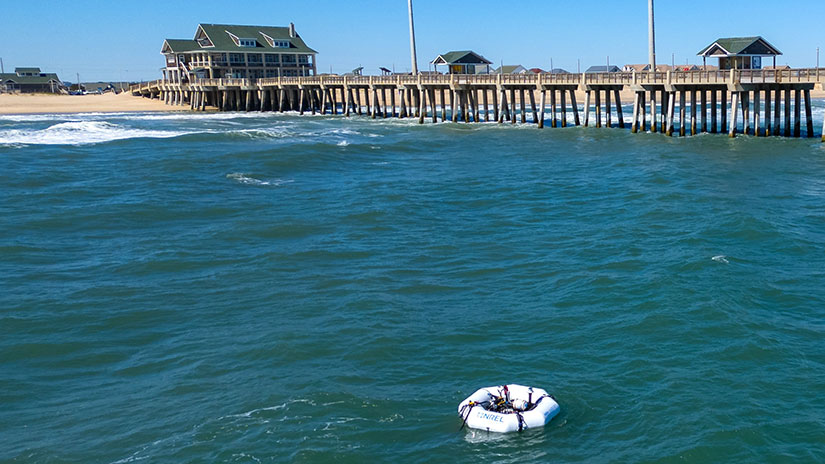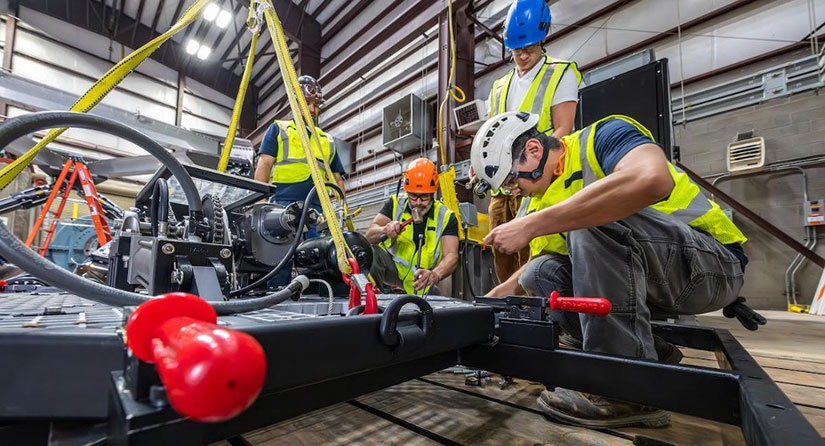Device Deployments Help NREL Researchers Identify What Is Broken—So They Can Get To Work Fixing It
Lessons Learned From Deployments of NREL’s Own Wave-Powered Desalination Device Help Guide Its Next Iteration

When Brittany Enos went to bed in Nags Head, North Carolina, on the night of March 18, 2024, she was feeling a little nervous. Outside her hotel room, the wind howled, rain battered the windows, and thunder roared. And floating in the nearby ocean, a wave-powered desalination device built by the National Renewable Energy Laboratory (NREL) was being jostled by the storm. Enos was crossing her fingers that the device would weather the intense wind and waves.
By that time, NREL’s hydraulic and electric reverse osmosis (HERO) wave energy converter (WEC) had been anchored to the seabed about 500 feet off of Jennette’s Pier in Nags Head for nearly a week. The NREL engineering team that built the HERO WEC, including Scott Jenne, Andrew Simms, and Justin Panzarella, had already left North Carolina’s Outer Banks the day before the storm, feeling satisfied with the information gathered in the deployment.
But Enos, a member of the NREL communications team covering the deployment, stayed behind to gather photos and video with other members of her team. When she awoke the next morning, she saw that the system monitoring the HERO WEC’s pressure levels and energy outputs was no longer producing data. She headed straight to the pier where the WEC, thankfully, was still in place. But the reverse osmosis system’s gauge showed the pressure was low, indicating that something was wrong.
After several phone calls and help from the team at the nearby Coastal Studies Institute (CSI), two CSI divers swam beneath the surface to identify the problem: The storm’s roiling waves had spun the HERO WEC so many times that the wire rope anchoring it to the sea floor had wrapped around the water intake hose and cut it.
“We ended up having to call that deployment a done deal,” said Jenne, the lead marine energy systems engineer on the HERO WEC project. “So, we went back to the drawing board and developed a new solution.”
The lesson from that deployment—that the WEC needed an improved anchor system, which the team designed in a matter of weeks—was just one of many the team has learned during two years of in-water testing. Now, the team will turn its attention to designing a new and improved version of the device, armed with their accumulated wisdom.
When Hiccups Lead to Insight
The HERO WEC device was originally built as a way for the CSI team to rehearse deployments in advance of the U.S. Department of Energy’s (DOE’s) Waves to Water Prize finale. But the HERO WEC, which is funded by DOE’s Water Power Technologies Office (WPTO), fulfilled more than that practical purpose over the course of five deployments. It has proven to be a fully functioning WEC that can use either a hydraulic or electrical system to pump seawater through an onshore reverse osmosis system and produce fresh drinking water (a process called desalination).
All five deployments have taken place in Nags Head because of the area’s wave conditions. NREL’s partnership with CSI has also played a key role in all of these installations—their team brings a wealth of knowledge about the ocean.
“CSI has great facilities, great capabilities,” Jenne said. “But the wave climate there is also a really good representation of the wave climate in smaller island communities, like Puerto Rico.”
That key detail is important because the HERO WEC was designed to be easily deployable for island communities that need access to clean drinking water.
“The waves at Nags Head make it a great test site with chaotic conditions that we have to learn how to survive,” Jenne said. Case in point: the weather-related hiccups experienced during the deployment in March and another a month later.
In April, when another storm rolled in while the HERO WEC was deployed off Jennette’s Pier, Jenne and the team decided to put the device in “safe mode.” That meant turning off the electrical storage to reduce the loads on the anchor to keep it from dragging amidst the choppy waves. That load reduction had an unintended effect, though, allowing the WEC to reach the end of the winch line so many times that it cut the wire rope attaching the WEC to the anchor. The lesson? The HERO WEC needs a much more resilient mooring line.
HERO WEC 2.0
Revisions to the mooring setup are on the to-do list for the next version of the HERO WEC. And the team is already working on an idea to replace the existing stainless steel wire rope with a polyurethane flat belt—like ones used in elevators—to dramatically extend the lifetime of the mooring. The team will validate the belt using NREL’s large-amplitude motion platform to mimic the motion the WEC might encounter over a long period of time. “If that change is successful, it should help with a lot of these issues, making it a much more robust system.”

The team will test the resiliency of a polyurethane flat belt with fatigue simulations on the large-amplitude motion platform located at NREL’s Flatirons Campus in Colorado. Image by Josh Bauer, NREL
Robustness, reliability, and deployability are among the primary objectives for the next HERO WEC iteration, which will also be funded by WPTO.
“One of the biggest design changes planned for version two is deployability,” said Panzarella, who began working on the device as an NREL intern and is now a full-time researcher. “We've been looking into downsizing the hydraulic pump to reduce anchor loads and potentially reduce the size of a transfer hose, which would further improve ease of installation.”
Another potential change is to the structure of the WEC itself—from an inflatable raft-like design to a more rigid frame. “It could make the device easier to install, easier to transport and easier to work on,” Panzarella said. One key benefit would be allowing in-water divers to access control panels from the side of the device instead of having to reach up and over the WEC to get at them.
Panzarella has several other upgrades in mind for the next round. “We're looking into potentially changing the gearbox and other drivetrain components so that we're constantly operating in higher-efficiency zones,” Panzarella said.
Acquiring Just the Right Data
When the team designed the first iteration of the HERO WEC, they were not quite sure what information they would need to collect from it. So, they took a “more is more” approach, equipping it with a fairly complex—and heavy—instrumentation system to track all kinds of data. Andrew Simms, an NREL researcher who analyzes the data collected from the device, wants to simplify and streamline that instrumentation system in the new version.
“Instead of just looking at the data after the fact and saying ‘hey, we found this interesting thing,’ we can optimize what we want to collect,” Simms said. He hopes the team will develop some hypotheses about what the device can do—in terms of energy production and water output—and then develop instrumentation accordingly.
Simms is still collating, organizing, and verifying all the data from the recent HERO WEC deployments. He tries to ensure that all the data, which are available in the Marine and Hydrokinetic Data Repository (MHKDR), are well documented in a usable format so that NREL can continue to foster a collaborative environment that yields efficient new renewable energy technologies.
Expanding the Reach of the HERO WEC
This next iteration will be key to informing WPTO’s strategic direction with regards to their wave-powered desalination research portfolio. The HERO WEC will provide key performance metrics, a proof of concept, and data that will enable WPTO to set reasonable research goals and appropriately prioritize research funding.
And while the original HERO WEC was constrained by the Waves to Water Prize, the team has a little more freedom to plan their next version, which they hope to have designed, built, and ready to deploy by the summer of 2026.
“If version two is as good as we hope it is, then there's a good chance that we could imagine building up a couple more of these,” Jenne said, adding that it would be ideal to run the hydraulic and electric configurations side by side.
“My vision at some point would be to have five to 10 of these all over the country collecting data at the same time,” he said. “One of the major objectives of this project is not just to build the technology but to collect all the data—to share our learnings with others. And we can do that a lot more effectively if we can put more devices in the water at the same time.”
Learn more about NREL's research in marine energy and the HERO WEC device and its open-source data. Then subscribe to The Current, NREL's water power newsletter, to stay up to date on the latest research.
Last Updated May 28, 2025
